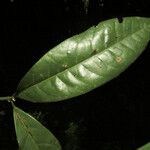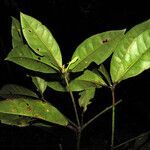Tree, trunk 4-18 m high, to 40 cm diam., angled and fluted basally; buttresses ca. 40 cm high x 200 cm diam. x 10 cm thick; outer bark whitish or greyish, scaly or smooth. Leaves opposite, or sometimes opposite and alternate on same tree (Mori et al. 22686); petiole 1-4 cm long; blade subcoriaceous, glabrous, narrowly to broadly obovate, elliptical or oblanceolate, to 25-30 (-42) x (7.5-) 13.8 cm, apex obtuse to abruptly acute to shortly or tapering-acuminate, base acute or obtuse, margin sometimes undulate. Inflorescence cauliflorous, or sometimes borne terminally on branches (male flowers), or cauliflorous (female flowers), a many-flowered, lax, dichotomously branched cyme or panicle to ca. 15 x 8 cm; peduncle ca. 3-9.3 cm long, yellow; branches densely and minutely rufous-puberulent. Flowers unisexual, sometimes bisexual; perianth green or yellowish-green when young, rose at base when mature. Male perianth urceolate and generally wider than female perianth, to ca. 5 x 3 mm, sparsely puberulent outside, lobes somewhat ruffled, ca. 0.3-1 x 0.4 mm; stamens 6(9), filaments white, anthers pinkish-white or brown. Female perianth narrowly tubular, 4 x 1.5 mm (including lobes); style with stigma exserted ca. 0.5 mm beyond lobes. Anthocarp ovoid, subgloboid, oblongoid or ellipsoid, to 1.7 x 1.0 mm, glabrous, dark red or reddish-purple.
More
A small tree. The trunk is 4-18 m tall and 40 cm across. It is angled at the base. It can have buttresses 40 cm high and 200 cm across and 10 cm thick. The outer bark is light brown. The leaves are large. They are 25-30 cm long by 14 cm wide. They taper to the tip and can have wavy edges. The flowers are small and at the end of branches or on the trunks. The fruit are purple and 1.5 cm across.



